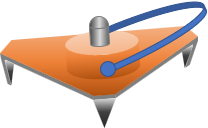4. Turning Points
Any point used to hold an elevation, even temporarily, should have a distinct top and be stable. Most formal benchmarks are either domed disks set concrete or spherical topped invar bars driven to refusal. When running a geodetic circuit to establish local networks, turning points are often needed as intermediate temporary elevations. To maintain circuit integrity, a physical object used as a turning point must also have a distinct top and be stable. Flat surfaces such as sidewalks, pavements, etc, should not be used because they may have a slight slope or the rod base may not sit flat.
Chapter B. Differential Leveling Section 2 Equipment identified two objects, steel pins and turtles, typically used for turning points. These same objects are used for geodetic leveling although the pin is usually stainless steel and has a driving cap. With the cap on, Figure H-17(a), the pin is driven into the ground. Once the pin is solid, the cap is removed revealing a spherically topped stub used as the actual turning point, Figure H-17(b).
 |
 |
| (a) Driving | (b) Surveying |
| Figure H-17 Pin |
|
The cap, usually attached with a chain, protects the stub during hammering.
A turtle, Figure H-18, is either a circular or triangular plate with three short legs and a centrally located spherical top stub.
 |
| Figure H-18 Turtle |
The plate is heavy so when dropped it drives the legs into the ground. On hard surfaces such as pavement or sidewalks, dropping the turtle will still generally cause its legs to bite into the surface. With only three legs, it will not wobble on a hard surface. The turtle can be used on sloped surfaces since the top of the stud is spherical and will have a distinct top at various orientations.